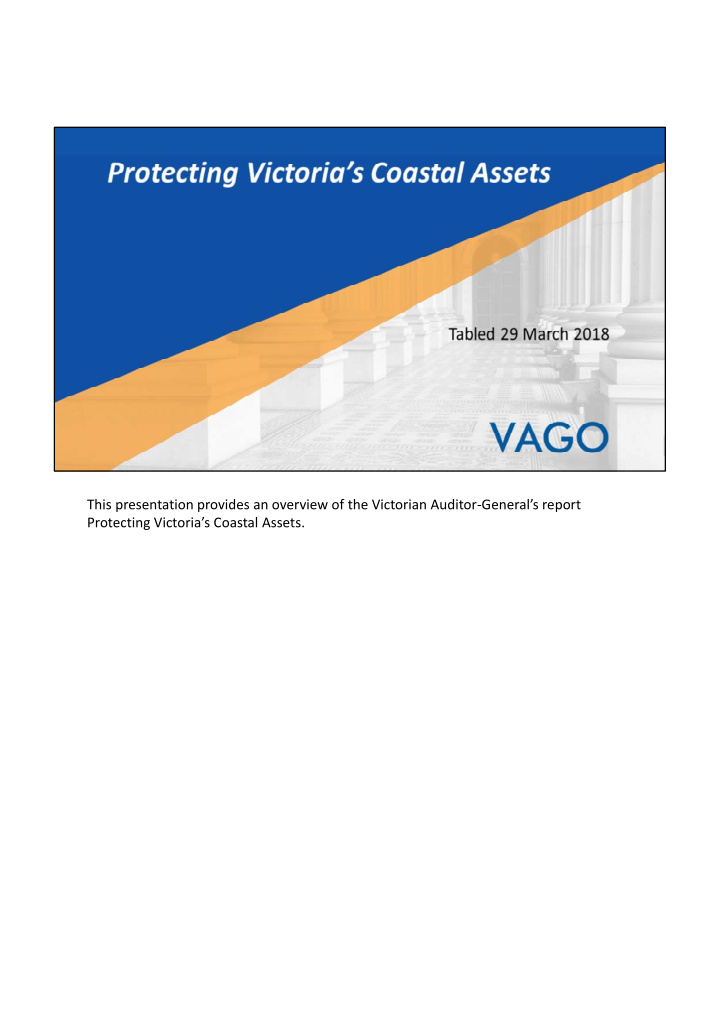



This presentation provides an overview of the Victorian Auditor ‐ General’s report Protecting Victoria’s Coastal Assets.
Built and natural coastal assets provide important services to Victoria’s environment, economy and community. They also protect other assets and infrastructure, such as drainage and sewerage networks, against coastal erosion and inundation hazards. Inundation is a temporary or permanent flooding of low ‐ lying areas. While protecting our coastal assets is important now, it will become even more so with the predicted effects of climate change and population growth.
DELWP is responsible for managing coastal assets on public land which covers 96 per cent of the coast. DELWP delegates much of this management to Parks Victoria (PV), coastal councils and committees of committees of management. Other coastal assets are managed by local port managers and asset managers, such as VicRoads.
We examined the: adequacy of coastal asset managers’ asset and risk management practices • coastal asset funding and expenditure, and • the statewide coordination of coastal asset protection by DELWP. • We also assessed the adequacy of coastal reforms proposed by DELWP to address longstanding issues impacting the protection of coastal assets.
We audited the following seven agencies that represent coastal managers of different types and sizes: DELWP • PV • Gippsland Ports • East Gippsland Shire Council • Mornington Peninsula Shire Council • the Great Ocean Road Coast Committee, and • VicRoads. •
Victoria’s coastal assets are not being adequately protected from current and future coastal hazards. Victoria is at real risk of losing valued coastal assets and infrastructure as a result of increasing coastal inundation and erosion hazards, if things do not change. Some locations will be significantly affected by sea level rise as early as 2030. The government has recognised this and in 2015 called for coastal management reform. DELWP responded by proposing a range of actions. We found that agencies generally manage the safety risks posed by failing assets, but overall asset management practices are poor and not aligned with risk. There are critical gaps in asset information and coastal hazard knowledge, and asset management systems do not meet accepted standards. As a result, the scarce funding available is not being effectively targeted to high ‐ value high ‐ risk assets, but rather those that are failing irrespective of their need and service. DELWP’s proposed actions will address a range of longstanding issues impeding the effective protection of coastal assets, but they must be resourced and implemented to ensure change in practice across the coast and all its managers.
No audited agencies have complete and robust information on their coastal assets, although they generally have good knowledge of failing assets. Additionally, no asset management systems were found to meet government standards, and agencies had generally poor understanding of the current and future risks to their coastal assets. This limits the ability of agencies to share information with DELWP and other managers to compare asset risks and prioritise works and funding across the coast.
Each of the seven audited agencies is engaging in some good on ‐ ground works to manage and protect individual coastal assets at risk of failing. However, short ‐ term funding and restrictions on where funding and revenue can be spent, mean coastal managers implement short ‐ term, reactive, localised—rather than preventative—approaches to asset management across the entire coast. Scarce funding also does not properly consider asset risks, resulting in significant unfunded maintenance and treatment works.
Limited oversight by DELWP and its predecessors has led or contributed to a range of longstanding issues including: poorly integrated and overly complex coastal planning and management • managers’ skills and capacity not aligning to what is needed to manage risks • a lack of clarity around roles and responsibilities for asset management, and • a lack of transparency around coastal funding and expenditure. •
In 2015, the government called for the reform of coastal and marine management. DELWP has proposed a range of legislative and non ‐ legislative actions to achieve this reform. For reform to be effective, all actions need to be resourced and prioritised so they can be implemented across the coast and all its managers in a timely manner.
We made three recommendations for DELWP to: • improve its knowledge of coastal hazards and assets • strengthen its oversight of all coastal managers • and to develop a sustainable funding and management model. We made three further recommendations for coastal managers (including DELWP) to: • address gaps in asset and risk management practices • strategically target their asset funding and expenditure based on risk • and to assess and action climate change risks from coastal hazards. All agencies have accepted the recommendations.
For further information, please see the full report of this audit on our website, www.audit.vic.gov.au.
Recommend
More recommend